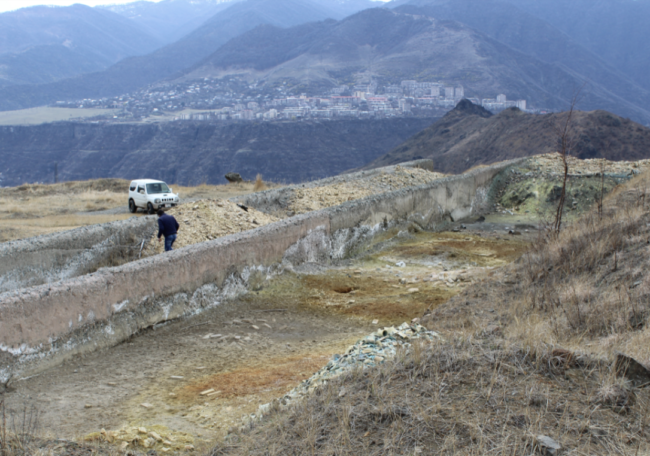Assessment of hazardous waste (arsenic graveyard) and planning reconstruction/cleanup in marz Lori, Armenia
Number of residents/children at risk: 100
Source of pollution/contaminants: mining tailings, Pb, As, Hg
Implementer: EHPMI
Total cost: $20,000
Project term: 1 yearNumber of residents/children at risk: 100Source of pollution/contaminants: mining tailings, Pb, As, HgImplementer: EHPMITotal cost: $20,000
Arsenic graveyard, Alaverdi-Madan route, Armenia
The arsenic graveyard is located less than 1 km north of Alaverdi, around the road leading to the “Madan” neighborhood. The graveyard is located on the heal by Lalvar river. The graveyard has 130 m width and 150 m length. The site was built in 1978-80 as a toxic waste storage facility for Alaverdi Copper Smelter Company. The site has a length of 150 meters and a width of 130 meters. The distance from the nearest settlement (Madan district of Alaverdi) is about 1 kilometer. In 2010 a crack has appeared on the concrete part of the graveyard. Some samples of soil were tested in the Center for Ecological-Noosphere Studies (CENS) of the National Academy of Sciences RA. The concentrations of arsenic and mercury were found to exceed the MACs 10-30 times.
The biggest environmental and public health threat is the location of the graveyard in an active seismic zone, as possible earthquake might lead to uncontrolled spread of the buried hazardous waste. According to the smelting company, the graveyard was fenced in the past, but the fences were stolen. In 2009, when the issue of unregulated graveyard was raised, the smelting company added signboards and fenced the graveyard. The walls of the graveyard are not hermetic, the cracks and holes give access to air and rain water, which results in the leakage of hazardous waste to the underground water and eventually to the riverbank. The expert group of the National Seismic Protection Service agency of the RA Ministry of Emergency Situations found out that the 150 m long և 130 m wide graveyard had 3 floors, one of which is completely open, and the other two – 6,8-7,2 m, are on the third (from 5) degree of emergency situation.

According to the specialists tօ mitigate the risks it is enough to isolate the graveyard. The in-situ testing of soil samples in Arsenic graveyard was performed by XRF analyzer on March 16 of 2019. In total, 43 surface and four pits dug tests (dept 10 cm) were performed. The duration of the testing time was 60 seconds. In soil samples, the concentration ranged for arsenic, lead, mercury, cadmium, and chromium was 28-113966 ppm, 32-80951 ppm, 11-1063 ppm, 26-667ppm, and 74-883 ppm respectively.
Proposed Solutions/ Project Objectives:
- Conduct Detailed Site Assessment (DSA) to map the contamination of the area.
- Develop an action plan to prevent spreading contamination.
